
by Lucas Joel Tuesday, September 20, 2016
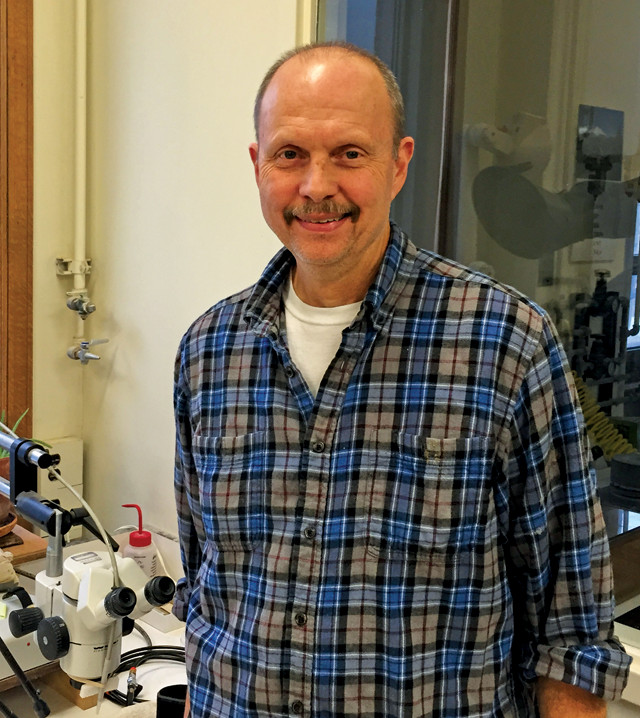
Bob Masek standing by fossil preparation equipment at the Field Museum of Natural History in Chicago. Credit: Lori Grove.
When paleontologists unearth a fossil and rock still entombs part of it, they take it to someone like fossil preparator Bob Masek, who cleans and prepares the fossil for scientific study, and sometimes for display in a museum. In the 1990s, Masek helped prepare “Sue,” the most complete Tyrannosaurus rex fossil ever discovered, which now stands in Chicago’s Field Museum of Natural History.
Masek’s path to fossil preparation was “through the back door,” he says. Before getting into the field, he didn’t have any formal education in paleontology, and he held a factory job that he didn’t particularly like. But hikes through the fossil-rich hills southwest of Chicago, his hometown, led him to begin collecting fossils, which he would sometimes try to clean. After bringing some of his finds to the Field Museum for identification, Masek found out that fossil preparation could be a real career — not just a hobby. And he never looked back.
I first met Masek in Chicago in winter 2014. By then, he had moved on from his job at the Field Museum and was working in the fossil lab of paleontologist Paul Sereno at the University of Chicago. There, he helped prepare fossils like “SuperCroc” — a Cretaceous crocodilian about 12 meters long. Masek talked about his work on the team that prepared Sue, which he called a “once-in-a-lifetime experience.” His stories stuck with me, and, last winter, I called him at his home laboratory — where he now works as a freelance preparator — to speak with him about his life and career.
LJ: You weren’t always a fossil preparator, right?
BM: No, I wasn’t. My work history starts in factories. I worked for Westinghouse Electric for more than 10 years, and I worked at another factory making grids for suspended ceilings. I ran the machines that spit out bars of metal, and I always thought there had to be something better than that in life for me.
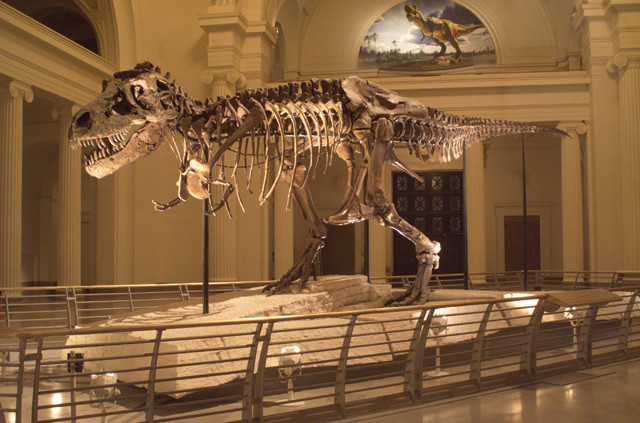
"Sue" the Tyrannosaurus rex on display in Stanley Field Hall at the Field Museum of Natural History in Chicago. Masek was part of the team that prepared Sue for study and display. Credit: ©The Field Museum.
LJ: Where and when did you discover your interest in fossils?
BM: I always liked collecting rocks. Growing up, I would collect colorful rocks like granite, but fossils weren’t really the focus yet. When I got married at 24, in 1979, my in-laws had a summer place about 100 kilometers southwest of Chicago where the famous Mazon Creek fossils are found. There were rows and rows and rows of hills. I would go hiking through them, and I started finding fossils — mainly of ferns — and that’s what sparked my interest. I started wondering: “Why are there ferns in these rocks?”

Masek (in red shirt on the right) at work on Sue's bones in the McDonald's Fossil Preparation Laboratory at Chicago's Field Museum of Natural History. Credit: ©The Field Museum.
Once I discovered fossils, I sort of forgot everything else. It got into my blood so strongly that that’s all I wanted to do. All of my money was going to my family, but to collect fossils — especially the Mazon Creek fossils — all you needed was a bucket and a screwdriver to pick them out of the ground and the hills.
LJ: So then did you think: “I need to make these fossils look better”?
BM: I was working in my garage — I made my own little chisels out of parts from factory machines. I also coated [the fossils] with a spray to make them stand out — which I now know was the wrong thing to do: You want to put on a coating that can be removed if somebody wants to study them later on. I then started bringing my finds to the Field Museum to get them identified. That’s when I discovered that not only are there people who research the fossils, they need people who prepare the fossils — to clean them and make them presentable for study. I said, “Alright! Here’s something interesting. Instead of running a machine and hating my job, here I can have a job and love it.”
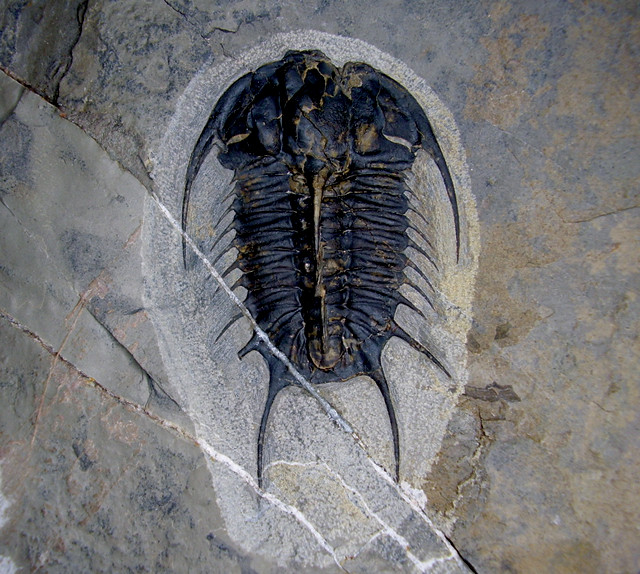
This specimen of Olenoides sp., a Cambrian trilobite from Utah that is about 6 centimeters long including its spines, took about 50 hours of preparation time to expose. Credit: Bob Masek.
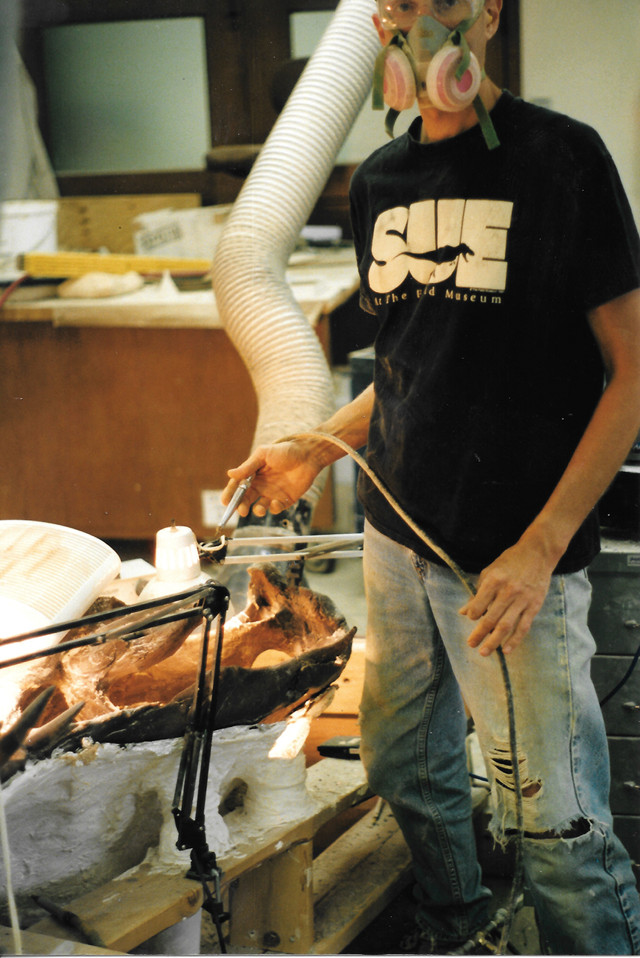
Masek preparing Sue's bones at the Field Museum. Credit: Bob Masek.
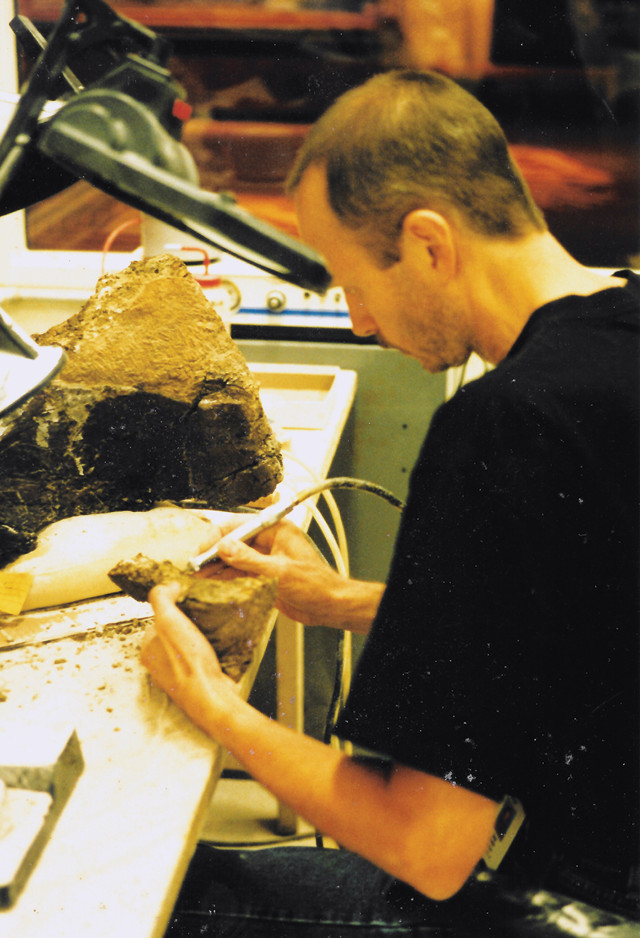
Masek working to prepare the skull of Sue the T. rex with an air abrasion machine. Credit: Bob Masek.
LJ: How did that lead to you working at the Field Museum?
BM: I first became a volunteer [at the Field Museum] in 1988. Someone at a rock show told me that Lance Grande’s preparator had quit, and so I called Lance the next day and told him I wanted to learn preparation. He told me that if I would volunteer two to three days a week he would let me learn how to clean fossil fish. So, I switched my work hours from days to nights so I could go to the museum during the day and learn fossil preparation. I was at the Field Museum for 10 and a half years, and then 15 years with Paul Sereno at the University of Chicago.
LJ: How did you go from being a volunteer to being a professional preparator?
BM: At first I would be given fossils from the Green River Formation that weren’t anything special, and that’s how I learned basic preparation techniques — you go step by step, working on better and better fossils. It took me about 10 years before I felt comfortable making my own decisions working on fossils. You learn about techniques and tools and chemicals, and you use them over and over. The main thing is judging how to go about preparing the fossils so that the bones are always supported, and how to end up with a fossil that is as exposed as it can be.
LJ: I imagine your work requires prolonged periods of careful focus.
BM: Yes, some things can take months, especially small fossils, which are really challenging. How do you hold a small fossil without breaking it? As you’re preparing it, the fossil gets more and more delicate. You’re working on one side and your fingers might be breaking something else on the other side.
LJ: When did you start working on dinosaurs?
BM: While I was at the Field Museum I met Paul Sereno, who found the [first fossil of the] dinosaur Eoraptor. I told Paul, “If you need a preparator, I’m interested in working on Eoraptor.” So Paul asked me if I wanted to come work for him, and I quit the Field Museum in Chicago after working there for eight years. But then the Field Museum got Sue the T. rex, so after just six months of working for Paul, I went back to the museum in 1998 to work on Sue for two years.
LJ: What was your part in preparing Sue?
BM: The skeleton was split up. The skull and the bones all the way back to the hips were kept at the Field Museum, and the legs and the tail were sent to the Walt Disney World Resort in Florida [which, along with the McDonald’s Corporation, had helped fund to be prepared. I worked on the skull, the ribs and the hips as part of a team. In one jaw, I rebuilt the teeth that had been pushed up into the palate; we took the jaw off and the teeth were crushed like pancakes. I also discovered the stapes [the innermost middle-ear bones], which were the first ones found in a T. rex. When all the parts were done, they were all brought back to the Field Museum and assembled. The real skull is in its own display case on the second floor because it’s too heavy. We molded the skull and made a cast, and that’s what’s on the mount that you see in Stanley Field Hall. Working on that project and being part of that team was a lot of fun. It was a highlight of my life. I have a lot of articles and memorabilia from it, and I made a lot of friends.
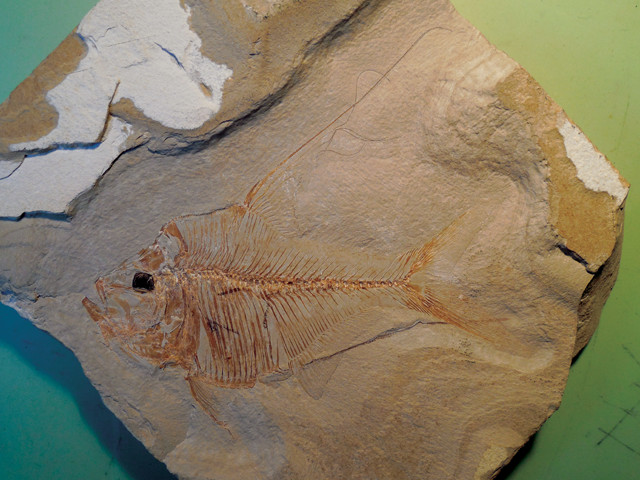
Masek prepared this 15-centimeter-long fossil fish, which was found in Cretaceous rocks in Lebanon. Credit: Bob Masek.
LJ: After Sue, you then went back to work for Paul Sereno. How did that experience differ from working at the museum?
BM: Well, Paul works on crocodiles like SuperCroc (Sarcosuchus), pterosaurs, and many different dinosaurs he’s found in Africa, China and the western U.S. Those are all things that I would never have gotten to work on at the Field Museum. Paul liked to have the fossils prepared, and then Tyler Keillor would make a fleshed-out version of the fossil. Paul was a National Geographic Explorer-in-Residence, so many of these things would be announced in Washington, D.C., at National Geographic’s headquarters. Nigersaurus was in the news, and so was Sarcosuchus — there’s a fleshed-out model of Sarcosuchus that’s more than 12 meters long. I like being involved in the cutting-edge research that goes on. I like doing work that’s going to be published, because I feel like I’m doing something for society, for the advancement of science.
LJ: What would you say to somebody who’s interested in fossil preparation?
BM: Almost everybody that I know who is a fossil preparator has a love of nature, a love of being outside and a love of animals. But, for working on fossils, you need to have a level of patience where you can sit and look through a microscope for hours at a time. You need to be able to concentrate on one thing and realize you’re not going to get it done in an hour, a day, a week, or even months.
LJ: How does it feel now looking back over your career?
BM: I never thought I would be doing what I’m doing. If you asked me when I was working in a factory if I would be working as a fossil preparator, or even know what a fossil preparator was, I would have said no. And while my mother and father have both passed away, they both got to see me working on fossils, so I’m glad for that.
© 2008-2021. All rights reserved. Any copying, redistribution or retransmission of any of the contents of this service without the expressed written permission of the American Geosciences Institute is expressly prohibited. Click here for all copyright requests.